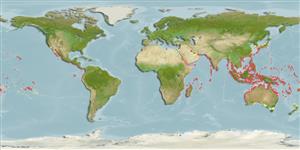Gastropoda |
Neogastropoda |
Conidae | Coninae
Environment: milieu / climate zone / depth range / distribution range
Ecology
Benthic; depth range 0 - 10 m (Ref. 349). Tropical
Indo-Pacific.
Length at first maturity / Size / Weight / Age
Maturity: Lm ? range ? - ? cm Max length : 15.0 cm SHL male/unsexed; (Ref. 349); common length : 10.0 cm SHL male/unsexed; (Ref. 349)
Locally used as food. This species is very poisonous which can inflict painful, and perhaps fatal bites (Ref. 349). Found under stones and coral slabs. Mainly feeding on small coral fishes (Ref. 349). Shelters at daytime and comes out to hunt at night, immobilizing its prey with its harpoon-like tooth. A venomous species (Ref. 85382), releasing a poisonous dart from the anterior end when handled (Ref. 801).
Life cycle and mating behavior
Maturity | Reproduction | Spawning | Eggs | Fecundity | Larvae
This species is a non-broadcast spawner. Life cycle does not include trocophore stage. Also Ref. 833.
Poutiers, J.M. 1998. (Ref. 349)
IUCN Red List Status (Ref. 130435)
CITES status (Ref. 108899)
Not Evaluated
Not Evaluated
Threat to humans
Human uses
| FishSource |
Tools
Internet sources
Estimates based on models
Preferred temperature
(Ref.
115969): 23.9 - 29.3, mean 28.3 (based on 3406 cells).
Vulnerability
Low vulnerability (10 of 100).
Price category
Unknown.
